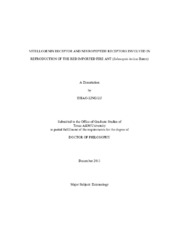| dc.description.abstract | Social insects have complex forms of social organization. Molecular mechanisms involved in the regulation of their reproduction are not fully understood. This dissertation investigated the vitellogenin receptor (VgR), short neuropeptide F (sNPF) receptor, and two insulin receptors (InRs) in the red imported fire ant Solenopsis invicta, focusing on their possible roles in the regulation of queen reproduction. Knowledge of these receptors may provide novel ways to manipulate either reproductive castes or overall reproductive outcome, diminishing the fire ant impact as invasive pest.
Fire ant virgin queens have more abundant VgR (SiVgR) transcripts than newly-mated queens, but limited egg formation. To elucidate whether queen maturation involved changes in SiVgR expression, we investigated both virgin and mated queens. In both queens, immunofluorescence analysis of ovaries revealed differential SiVgR localization in early and late stage oocytes; however, mated queens showed higher SiVgR expression than virgin queens. In virgin queens, the SiVgR signal was first observed at the oocyte membrane beginning at day 12 post-emergence, coinciding with the maturation period required before a mating flight. SiVgR silencing in virgins through RNA interference abolished egg formation, demonstrating that SiVgR is involved in queen ovarian development pre-mating.
The sNPF and insulin signaling pathways have been implicated in the regulation of food intake and body size, and these peptides also play a gonadotropic role in the ovaries of some insect species. To elucidate the sites of action of the sNPF peptide(s), the sNPF receptor tissue expression and cellular localization were analyzed in the queen brain, subesophageal ganglion (SEG), and ovaries by immunofluorescence. Results suggest that the sNPF signaling cascade may be involved in diverse functions, and the sNPF peptide(s) may act in the brain and SEG as neurotransmitter(s) or neuromodulator(s), and in the ovaries as neurohormone(s). In addition, to elucidate the role of insulin signaling pathway in the fire ant, two putative InRs were cloned. Transcriptional expression analyses show that the receptor abundance was negatively correlated with body size and nutrition status in fire ant immatures. In queens, the expression of InRs in different queen tissues correlates with tissue requirements for queen reproductive physiology and behaviors. | en |


